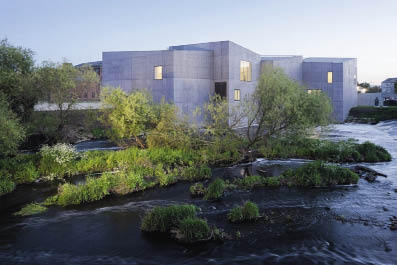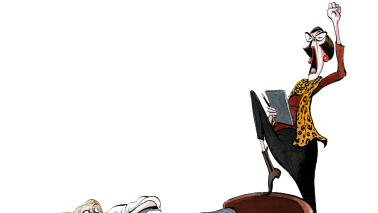James Hamilton says that regional art galleries are as evocative as local landscape
It is always a cause for celebration when a new art gallery opens. There is something about the existence of its galleries that indicates a nation’s state of health. Lively galleries demonstrate that a nation is not so caught in the imperative to pay for schools and hospitals that it can’t, in the worst of times, present the fruits of the difficult lives and hard-won insights of painters and sculptors. In Wakefield, following the Turner Contemporary at Margate, the Hepworth opened on 21 May. That two relatively small towns in the English regions should be so blessed with expensive new kit in difficult times is wonderful to see.
The architect of both galleries, David Chipperfield, has created museums from a group of blocks arranged together. In Margate, dressed in white, they shimmer on the shoreline, visible for miles from sea and land; in Wakefield, greyer and industrial in tone, they sit on the banks of the Calder, echoing the form of one of Barbara Hepworth’s own sculptures. From one of the Hepworth’s ten high, light galleries there is a view over the weir and the 14th-century Chantry Chapel that will surely become one of the sights of Yorkshire, as will the gift to the gallery from the artist’s family of 44 of Barbara Hepworth’s plasters and other works.
Amid the celebration of Hepworths in Wakefield there is, however, only a hint of the wealth of Wakefield’s own extensive art collection. The city kept alive the public purchase of modern art in the 1940s and 1950s, supporting Henry Moore and Hepworth when others rejected them. Moore’s early elmwood ‘Reclining Figure’, bought in 1942 for £150, is proudly on show among important drawings. Hepworth’s ‘Mother and Child’ group was another early acquisition, so were paintings by Victor Pasmore, Harold Gilman, Alan Davie and Patrick Heron. A few of these works are displayed, many others are not, but most were acquired in the early days in the teeth of intense disapproval by a conservative public and a staunch Labour council.
The showing of art has its key moment: a classic case is the Churchill government’s determination to keep the National Gallery open, if only with one painting on display, during the second world war. Likewise, there is also a moment not to show it. Thus it is a wasted opportunity both for gallery and artist that the Hepworth Wakefield should choose this moment to show Eva Rothschild’s work, or any temporary exhibition, when the gallery has treasures of its own waiting in the store. They can mount temporary exhibitions at any time, more or less, and not miss this golden opportunity, when all eyes are on Wakefield, to reveal more of the city’s 20th-century collection, from Norman Adams to Austin Wright. No disrespect to Eva Rothschild, but this is not yet the time for her party.
The difficulty at Wakefield is compounded by the certainly generous loans from the Tate, the Arts Council and the British Council. However magnificent these are (Pasmore, Hilton, Brancusi) they risk compromising the gallery’s focus and dazzling the viewer. Does the Hepworth Wakefield really want to be another London gallery or art store transported to the north? For very good reasons it is not Tate Wakefield. With Barbara Hepworth as its name saint, Hepworth Wakefield does not have to echo taste from the metropolis. Better by far to show proudly what the city itself pioneered in the past, and what by courageous early purchase the city owns.
The celebrations in Wakefield come at exactly the same time as the bitter news from Sheffield that the City Council is cutting the opening hours of the Graves Art Gallery to three mornings a week — Thursdays, Fridays and Saturdays. Government cuts, naturally. This 1930s gallery became part of a trust when the council relinquished responsibility for its art collections in the 1990s. The joy of the Sheffield galleries, when under the direction of Frank Constantine in the 1970s and early 1980s, and chaired by the romantic Labour politician Enid Hattersley (Roy’s mother), was their informality and openness. The Graves and the (already closed down) Mappin Art Gallery pioneered inventive temporary exhibition programmes; introduced the in-gallery café; mounted film seasons and life-drawing classes; hosted the first British Art Show. With, now, opening hours that would shame a private collection, the Graves seems more dead than alive.
Behind the multi-million pound projects, the Sheffield situation exposes a crisis in regional art galleries. The openings in Margate and Wakefield may not be such a joy if they mask subtle closures elsewhere. Our great municipal art collections — Bristol, Birmingham, Manchester, Sheffield, all of which have struggled ingeniously for years to make ends meet — have underlying core costs of security, conservation and display which are cut at peril. As a depressing background theme, curators are being made redundant or downgraded principally in favour of PR and marketing. This has been going on for years. Bury Council in Greater Manchester sold its Lowry in 2006 for £1.4 million, and now Bolton Council is selling 36 paintings, presumably with those curators who are left kicking and screaming.
Art and place are specifically inter-related. It is a small thing in the greater scheme, but Bury’s Lowry, Wakefield’s Hepworths, Sheffield’s Graves are real products of local history, and are as significant within their memory-landscapes as the hills around Sheffield or Wakefield’s extraordinary skyline. They exist there because individuals and small groups fought to acquire them for their towns, and went through adversity, making history, to do so. They reflect difference, local nuance and independence of government; that’s what is really at risk, not just paint on canvas.
Margate and Wakefield are finding courageous routes through this government-inspired crisis; Bury and Bolton miss the point; Sheffield can turn its lights on again. It is as callous to cut access to art collections or to see them as pathetic sources of petty cash as it is to deny public access to hills, parks and footpaths.
James Hamilton was keeper of art at Wakefield City Art Gallery 1974–76, and keeper of the Mappin Art Gallery, Sheffield, 1976–84. He is university curator at the University of Birmingham.






Comments